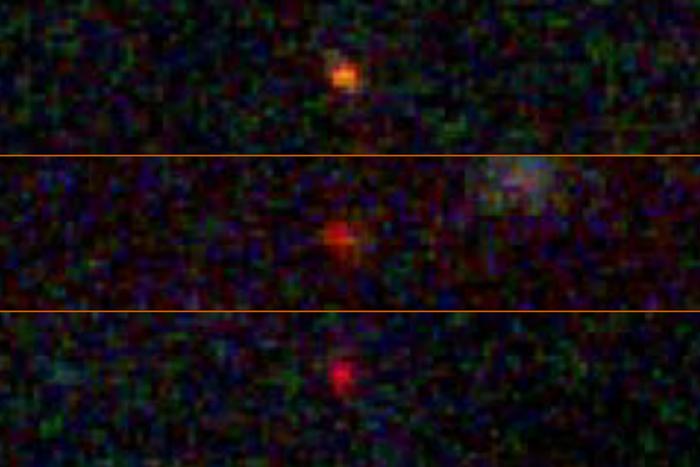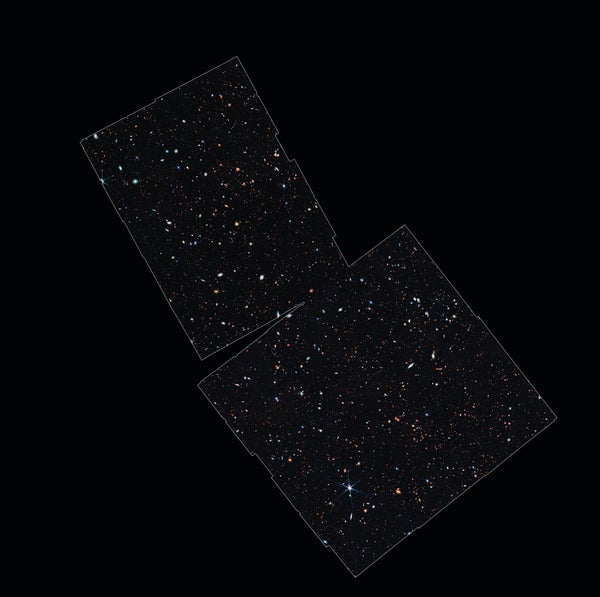In a first, the James Webb Space Telescope (JWST) might have glimpsed a rare type of star that astronomers aren’t even sure exists. These stellar objects, called dark stars, might have been fueled not by nuclear fusion but by the self-annihilation of dark matter—the invisible stuff that is thought to make up about 85 percent of the matter in the universe. Scientists will need more evidence to be able to confirm the candidates seen by JWST, but if these dark stars are real, the finding could change our story of how the first stars formed.
Contrary to their name, dark stars could have glowed a billion times more luminously than the sun and grown to a million times its mass. Dark stars have never been definitively observed, but cosmological simulations suggest that they should have formed soon after the big bang from clouds of pure hydrogen and helium that collapsed at the centers of protogalaxies rich in dark matter.
In July 2023 researchers reported in the Proceedings of the National Academy of Sciences USA that at least three far-off objects observed by JWST and previously identified as galaxies could, in fact, each be a single, supermassive dark star. “If you find a new kind of star, that’s huge,” says study co-author Katherine Freese, an astrophysicist at the University of Texas at Austin.
On supporting science journalism
If you're enjoying this article, consider supporting our award-winning journalism by subscribing. By purchasing a subscription you are helping to ensure the future of impactful stories about the discoveries and ideas shaping our world today.
The researchers can’t yet prove that the objects are dark stars—only that their characteristics are consistent with their being either dark stars or galaxies populated by regular fusion-powered stars. JWST’s technology is sufficient to do that job, however, says study co-author Cosmin Ilie, an astrophysicist at Colgate University. All researchers need is more observation time. “We hope we are going to find one of these dark stars with the Webb within its lifetime,” Ilie says.
There are two possibilities for how the first stars in the universe formed. The conventional wisdom is that these early stars were “Population III” stars. Such stars would have been powered by nuclear fusion, like stars today, but they would have had very little to no metal in them—in astronomy, that means elements heavier than helium—because those elements had not yet formed in the early universe.

JWST initially identified these three objects (JADES-GS-z13-0, JADES-GS-z12-0 and JADES-GS-z11-0) as galaxies in December 2022. One team suggests they might be “dark stars,” theoretical objects powered by the annihilation of particles of dark matter.
NASA, ESA
There is another possibility, though. In 2008 Freese and some of her colleagues proposed that the universe’s first stars could have been powered by dark matter. Dark matter is a mysterious form of matter that does not interact with electromagnetic forces; scientists know it exists only because of its gravitational effects, and they don’t know what it’s made of.
In the early universe, dark stars could have formed from the collapse of helium and hydrogen clouds made in the big bang. If dark matter particles are also their own antiparticles, as many dark matter theories posit, then within these collapsing clouds, those particles would have collided with one another and self-annihilated. The collision would have kicked off a chain of particle decay that ended with the production of photons, electron-positron pairs and neutrinos. Only the neutrinos would have really left the cloud because they barely interact with matter. The other particles would have hit the hydrogen and helium and transferred their energy to that matter, which would have heated up the cloud and fueled the star’s formation and continued growth.
These stars would have formed at the center of “minihaloes,” which were early protogalaxies that existed 200 million years after the big bang, before the advent of elements heavier than helium and hydrogen. These minihaloes consisted almost entirely of dark matter, making conditions within them ripe to power dark stars. This high concentration of dark matter is why dark stars could form only in the early universe, Freese says.
Because the stars would have been relatively cool and would not have emitted the high-energy photons that nuclear-fusion-powered stars do, they could have kept accumulating mass, swelling larger and larger over their lifetimes.
“Now you’ve got a weird thing,” Freese says. “It looks like the sun in terms of its surface temperature, but it’s a billion times as bright. It could be as bright as an entire galaxy of fusion-powered stars.”
At the end of their life spans, large dark stars would have collapsed into massive black holes. This could be a potential explanation for some of the ancient supermassive black holes observed in the universe, which seem too large to have formed so quickly from fusion-powered Population III stars, Ilie says.
To look for dark stars, Freese, Ilie and Jillian Paulin (at the time one of Ilie’s undergraduate students) searched the catalog of objects that JWST has identified as being from the early universe, or from nearly 14 billion years ago. They found adequate data about electromagnetic emissions for only nine of those objects. Of those nine deemed useful for study, three were a good match to what a dark star would look like. These objects had high redshifts, meaning they emitted light skewed toward the red side of the electromagnetic spectrum, which is a sign of old and distant objects. That light was also possibly from a single point source, such as a star, rather than a fuzzy galaxy, says Paulin, who is now a graduate student at the University of Pennsylvania.
The researchers can’t say much else about the objects right now, because they have only limited observations of them. The “smoking gun” for a dark star would be a hiccup in the electromagnetic spectrum indicating the absorption of light by a particular isotope of helium, which should happen only in dark stars, not in galaxies. To find that hiccup, they would have to observe these single objects for many months, Ilie says, which is unrealistic given how many researchers are using JWST to solve an array of astrophysics problems. The team can tell, however, that if the objects are dark stars, two of them are about a million times the mass of our sun, and one is about 500,000 times the mass of the sun.
The research team has started developing an automated method to search for more dark star candidates, some of which might require less observation time to confirm. “I’d expect there to be very many more candidates,” Paulin says.
Observing a dark star directly would be “off-the-charts” amazing, says Pearl Sandick, a theoretical particle physicist at the University of Utah. who was not involved in the study. There are, however, other ways to look for dark stars, such as via their signatures in the cosmic microwave background—the faint glow of radiation left over from when our universe was hot and young. Finding a dark star would not only give us a new look into the early formation of the universe, Sandick says, but also be a unique opportunity to directly observe dark matter interactions. “Observing that,” she says, “would really provide new insight about the nature of dark matter as a particle.”
